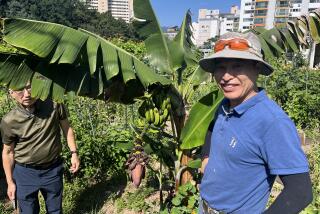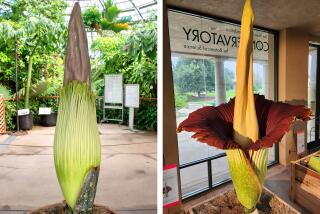A Rare Bloom Is Fading
- Share via
KODAIKANAL, India — On its own, the kurinji is a modest little flower, nothing you’d expect would send grown men into fits of rapture.
But blanket entire hillsides and valleys with it -- millions of blue and purple blooms as far as the eye can see -- and suddenly civil servants are transformed into poets.
“We were walking in early morning and it was covered by mist, and suddenly the mist cleared as if somebody lifted a curtain,” said S. Theodore Baskaran, a naturalist and retired postmaster. “And suddenly there was this vast landscape of flowers in front of us, the whole landscape up to the horizon covered in blue.... It was a very dramatic and kind of a transcendental experience.”
Such kurinji-induced euphoria is an infrequent occurrence, and not just because the flower is found in only one place on Earth: the chain of mountains in southern India known as the Western Ghats.
Unlike the annual bloom of poppies in Southern California’s Antelope Valley, the delicate kurinji appears just once every 12 years.
Baskaran has witnessed its glories only twice in three decades: in 1982, when he stumbled across the flower for the first time, then again in 1994. This year, he looked forward to having an opportunity to fall under the kurinji’s spell once more.
But anticipation among kurinji lovers has given way to dismay with the discovery that human intervention is robbing the flower of its natural habitat at a rapidly accelerating rate, through encroachment and the introduction of nonnative species in the high-elevation grasslands where it flourishes.
In many parts of the Western Ghats, the kurinji bushes that enliven the hills every dozen years are fighting to survive, increasingly squeezed by invading newcomers onto scattered, shrinking patches of land, like lakes of color steadily drying up.
For some, the swift devastation is nothing short of catastrophic, a rupture not only in the natural world but also in cultural tradition. The kurinji is celebrated in the ancient literature of south India, and some hill tribes revere it to this day. The members of one tribe even calculate their ages according to how many of the spectacular mass flowerings they’ve witnessed.
To watch the unraveling of such an established thread in the fabric of local life is painful, said John Britto, a botanist and Jesuit priest here in the state of Tamil Nadu.
“It’s impossible to digest that fact and accept it. As a person of this land and culture, it would be a terrible loss -- a whole sense of cultural history being lost,” Britto said. “We are wedded to the soil, to the land, to the plants, and that link between man and nature is getting lost. That’s irreparable.”
The takeover of the kurinji’s turf is being led by acacia, pine and eucalyptus trees, foreign species that multiply quickly and guzzle water. Some of these were first planted in the 19th century by British colonialists, who wanted a ready source of firewood and regarded the native vegetation as ugly and useless.
Since then, and especially in the last two decades, cultivation of these trees has turned into an important industry -- acacia for use in leather-tanning, pine for making crates, eucalyptus for oil. Tea and cardamom have also become cash crops in the area.
The proliferation of commercial plantations is helping to destroy the mountain grasslands, a finely balanced ecosystem for which the kurinji serves both as a symbol of nature’s abundance and as a bellwether of development’s depredations.
“It’s a flagship species. It’s an indicator of loss of habitat,” said Tanya Balcar, an Englishwoman who moved here more than 20 years ago.
“You can still find some blue bits. You can still find patches,” said Balcar, who helped establish a nonprofit organization, the Vattakanal Conservation Trust, to try to save the grasslands. But “it’s nothing like it should be or was.”
Record of the kurinji’s stunning effusions every 12 years dates back 2,000 years, when Tamil poets praised the flower’s beauty and rarity.
“From my schooldays I read poems about kurinji,” Baskaran said. “There are various references. They say that the honey collected from this particular flower is the best. A poet goes to the court of a king and says, ‘O king, who serves the honey from the kurinji flower to guests, may you long live!’ ”
In Hindu mythology, the god Shiva’s second son, Murugan, wore a garland of kurinji when he married; a temple dedicated to him, the Kurinji Andavar, sits on a hilltop here in Kodaikanal, with commanding views of the countryside below.
The kurinji plant comes in a number of varieties, blooming in shades from pinkish white to pale violet and in differing cycles, such as every three, four or 10 years.
It was the shyest variety that became the subject of verse and the object of veneration. Although its full name is neelakurinji, the people of these parts invariably mean the species that blooms every 12 years when they use the generic term kurinji.
It blooms mostly from early spring to late autumn, peaking in summer. Once spent, the bushes die, their seeds dispersing to germinate anew within a few months. As they grow, the shrubs add their dark-green hue to the verdant mountainsides until, at last, they’re ready to spring their secret.
In the mid-1800s -- around the same time some of their countrymen were introducing the alien flora that threatens the kurinji today -- British botanists in India began to document and spread knowledge of this curious little flower, describing for the wider world its breathtaking but strangely infrequent eruption in a riot of blue and purple.
“As an individual flower, it’s not attractive at all, I’ll tell you plainly,” Britto said. “But when the entire valley turns a violet color, that’s it. Its massiveness brings about a sea change.”
Hard figures on the shrinkage of the kurinji’s environment, which once measured 400 square miles by one estimate, are difficult to come by. But experts seem to agree that destruction of the mountain grasslands has accelerated since the last bloom in 1994, when swaths of hillside carpeted in kurinji still elicited gasps of delight.
Conservationists speak of the need for triage, an immediate effort to save what little pristine grassland remains, not only for the sake of the kurinji but also for animals that depend on the habitat, such as the bison and the rare Nilgiri tahr, a kind of goat.
Prospects of actively recovering lost ground are dimmer, both from a logistical and financial point of view, though Balcar says “eco-restoration” ought to be possible.
Trying to persuade the Indian government to step in and help has been an exercise in patience and frustration.
The needs of a flower, however celebrated, that shows up only once every dozen years can easily appear less urgent than other environmental concerns. Officials have made sporadic efforts to ban and uproot exotic trees, but tend to plant native ones in their place, for timber value, rather than preserve the area as grassland, which holds little commercial potential.
Perhaps, optimists say, the government could be convinced of the kurinji’s possibilities as a tourist attraction, like the fall foliage in New England. But how much can a local economy rely on such an occasional event?
When officials do express support for protecting the kurinji and its habitat, the good intentions often peter out as they trickle through layer after layer of India’s colossal bureaucracy. A recent proposal, for instance, to establish a small kurinji sanctuary here in Kodaikanal, on the slopes beneath a popular footpath known as Coaker’s Walk, came tantalizingly close to fruition -- until the cooperative district official expediting the plan was reassigned.
“Now this season is out,” Britto said in a rueful tone, then added hopefully: “Next flowering time, something should have come into existence.”
The curtain is quickly falling on this year’s bloom, as the purple flowers, in their isolated patches, wither and fade on their dark-colored stalks.
Soon all that will be left for kurinji lovers is to look forward to another cycle, a long wait during which children will grow up, waistlines will expand, governments will rise and fall, fads and fashions will spring up and pass away.
Devotees of the flower can only wonder what the next bloom will look like, and pray that, in 2018, the splendor in the grass will still be there.
*
More to Read
Sign up for The Wild
We’ll help you find the best places to hike, bike and run, as well as the perfect silent spots for meditation and yoga.
You may occasionally receive promotional content from the Los Angeles Times.







